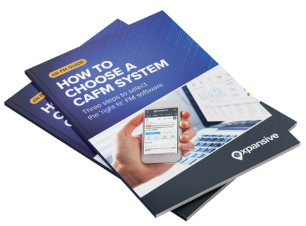There are four stages to the classic asset lifecycle: planning, acquisition, maintenance and disposal. But what data and digital tools will take the guesswork and potential disruption out of the way we manage each stage? What’s needed to extend the operational life of your assets and ensure their seamless replacement when the time comes?
Stage 1 - Planning
Knowing the right time to acquire new assets and replace existing equipment will depend on the data available to you. If you’ve been tracking and recording their service history within dedicated management software, you should have the tools to see when equipment is failing more frequently and likely to need renewing.
But if you haven’t, it might simply be a final and catastrophic failure that signals you need to invest again. In the world of purely reactive maintenance and unmanaged assets, the danger of unplanned expenses ruining your budget planning always looms large.
In an ideal world, decision-makers will identify the need for a new asset, then base their procurement decisions around data, including the value an asset is projected to bring to the business and its potential lifespan. The need for performance and longevity will be balanced against the budget available for the purchase.
If you’ve been tracking the acquisition and maintenance costs of the asset throughout its life, this data should inform that calculation and give you a good idea about how much you could and should be spending on a replacement.
.png?width=824&height=783&name=The%20lifecycle%20of%20an%20asset%20%E2%80%93%202%20(1).png)
Stage 2 - Acquisition
When the asset is acquired and deployed it should be added to an asset register. In some businesses this will be no more than an Excel sheet, while others will use a digital asset register to record full details about the equipment. Whatever the choice you make, the more detail you capture about the asset in your records, the more information you will have to inform your decision making throughout its lifecycle. These details should include:
- Description of the asset
- Barcode and/or serial number
- Location (it’s physical location in your estate)
- Status
- Condition grade
- Manufacturer/ model
- Date of purchase installation
- Purchase cost
- Warranty details and expiry date
- Lifetime expectancy
- Current value of asset
- Depreciation method used (for future ROI calculations)
When these details are captured in a digital asset register operating as part of a CAFM this data can use be used to:
- Trigger required planned and preventative maintenance activity
- Provide background information for those maintaining the asset
- Calculate ROI of the equipment over time
-
Estimate asset lifecycle for budget/replacement planning
Most modern-day management systems will also include asset tracking solutions such as RFID and QR labelling. When an asset is acquired a digital tag is attached to it, linking the equipment to the records in the register itself including its full service history.
Stage 3 - Utilisation and maintenance
In this stage of the asset lifecycle the FM team use reactive, planned and preventative maintenance to:
- Address critical failures and minimise downtime
- Fix non-critical ongoing problems and optimise equipment
- Perform annual servicing activity
- Meet compliance requirements
Depending on the sophistication of the digital tools you’re using, there will be a balance of reactive and planned maintenance designed to keep the asset working and compliant - while extending its useful life for as long as possible.
Using a maintenance management tool such as a CAFM will ensure a business is carrying out the right maintenance on the right equipment at the right time, as well as managing and tracking its performance effectively over time. Workflow automation ensures:
- Maintenance requests are triaged and processed quickly to avoid equipment downtime
- Regular servicing is done on time to assess condition and improve performance
- The business is not maintaining assets that are still under warranty
Throughout this stage of the equipment lifecycle, good CAFM software should be ensuring engineering and contractors are:
- Reporting on every callout outcome
- Updating condition notes
- Adding service logs
- Recording their time spent on each job
- Invoicing accurately for work done
In this way, the CAFM builds the data around the condition of each asset and the costs involved in keeping them running. Over time, the business will be able to see patterns in performance and condition that might give cause for concern (multiple breakdowns, increased frequency of breakdowns). And they will be able to see when the cost of maintaining the asset is likely to overshadow the cost of replacing it altogether.
Stage 4 - Disposal
At the end of its working life, the asset needs to be disposed of, re-purposed, sold off or recycled. With a greater ESG focus on the circular economy and increasing costs associated with asset disposal, it's becoming more and more important you can effectively monitor and control 'end-of-life'.
If you’ve only managed the asset on a reactive basis across its lifespan and have little or no data available about its performance it will always be more difficult to accurately predict when you will need to replace the equipment. The business risks replacing the asset too soon (before it’s strictly necessary) or making an emergency replacement when there’s a complete failure. In both cases, money, time and resource could be wasted.
On the other hand, businesses who have been maintaining and tracking the asset throughout its lifecycle using a digital asset register powered by a CAFM system will likely have all the right data available to ensure the best timing of a replacement.
Data acquired throughout the asset lifecycle available within a CAFM will help the business plan budgets more effectively. The use of dashboards, graphs and tables in FM software will help businesses visualise the deterioration of specific asset types, potential ongoing costs for supporting failing assets and help the business realise and plan for major Capex well in advance of the need.
At the same time, all the data around lifecycle, usage, performance, maintenance costs and ROI you have acquired can be utilised in the planning phase (see above) of the next acquisition cycle. It can help you make sure you buy the right equipment to meet your business needs.
Conclusion
Asset lifecycle management can have a dramatic influence on the effectiveness and overall profitability of a business. If equipment is prone to failure and is badly maintained it can cause business downtime, drive customers away and drain revenue.
Without the right software, asset maintenance can be reactive, siloed and shortsighted in the way it services assets and manages budget. Asset management done right, however, can increase business revenue, customer satisfaction and get the entire business working together to deliver on shared objectives.
As the IAM states in this video primer, good asset management strategy ‘maximises the long term value of the assets by aligning them to the objectives and purpose of an organisation’.
The right asset management software will help you;
- Procure equipment in line with business targets/budgets
- Maintain assets to required standards
- Elongate the life of assets to maximise budgets
- Minimise costly downtime and disruption
- Collect and share the asset management data across the organisation to support the business strategy
The right CAFM is a tool for everyone in a company to understand and manage the operational and financial effect the asset lifecycle has on a business, ensuring that their strategy is aligned.





